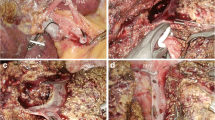Abstract
Objective: The objective of this study was to assess the feasibility, safety, and outcome of laparoscopic liver resection for benign liver tumors in a multicenter setting. Background: Despite restrictive, tailored indications for resection in benign liver tumors, an increasing number of articles have been published concerning laparoscopic liver resection of these tumors. Methods: A retrospective study was performed in 18 surgical centres in Europe regarding their experience with laparoscopic resection of benign liver tumors. Detailed standardized questionnaires were used that focused on patient's characteristics, clinical data, type and characteristics of the tumor, technical details of the operation, and early and late clinical outcome. Results: From March 1992 to September 2000, 87 patients suffering from benign liver tumor were included in this study: 48 patients with focal nodular hyperplasia (55%), 17 patients with liver cell adenoma (21%), 13 patients with hemangioma (15%), 3 patients with hamartoma (3%), 3 patients with hydatid liver cysts (3%), 2 patients with adult polycystic liver disease (APLD) (2%), and 1 patient with liver cystadenoma (1%). The mean size of the tumor was 6 cm, and 95% of the tumors were located in the left liver lobe or in the anterior segments of the right liver. Liver procedures included 38 wedge resections, 25 segmentectomies, 21 bisegmentectomies (including 20 left lateral segmentectomies), and 3 major hepatectomies. There were 9 conversions to an open approach (10%) due to bleeding in 45% of the patients. Five patients (6%) received autologous blood transfusion. There was no postoperative mortality, and the postoperative complication rate was low (5%). The mean postoperative hospital stay was 5 days (range, 2–13 days). At a mean follow-up of 13 months (median, 10 months; range, 2–58 months), all patients are alive without disease recurrence, except for the 2 patients with APLD. Conclusions: Laparoscopic resection of benign liver tumors is feasible and safe for selected patients with small tumors located in the left lateral segments or in the anterior segments of the right liver. Despite the use of a laparoscopic approach, selective indications for resection of benign liver tumors should remain unchanged. When performed by expert liver and laparoscopic surgeons in selected patients and tumors, laparoscopic resection of benign liver tumor is a promising technique.
Similar content being viewed by others
Author information
Authors and Affiliations
Additional information
An erratum to this article is available at http://dx.doi.org/10.1007/s00464-003-0012-y.
Rights and permissions
About this article
Cite this article
Descottes, B., Glineur, D., Lachachi, F. et al. Laparoscopic liver resection of benign liver tumors. Surg Endosc 17, 23–30 (2003). https://doi.org/10.1007/s00464-002-9047-8
Received:
Accepted:
Published:
Issue Date:
DOI: https://doi.org/10.1007/s00464-002-9047-8




